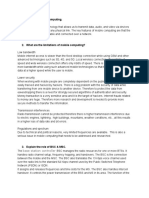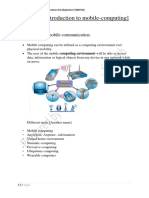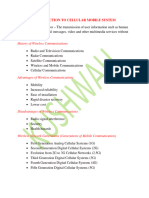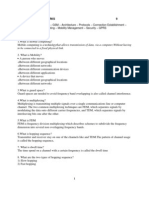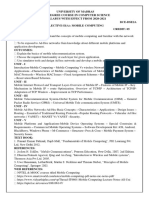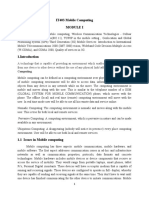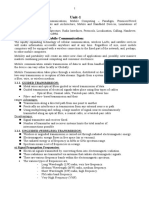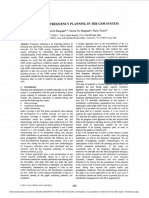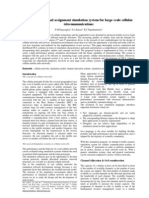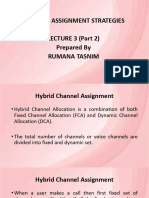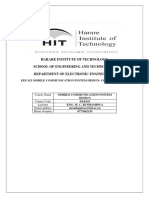SUNDER DEEP COLLEGE OF MANAGEMENT & TECHNOLOGY,
GHAZIABAD
(Affiliated with CCSU, MEERUT)
Topic Covered_____________________________________________________
Lecture No. __________ Date & Time of Delivering______________________
Mobile Computing
Unit-1
Mobile Computing is a technology that provides an environment that enables users
to transmit data from one device to another device without the use of any physical
link or cables.
In other words, you can say that mobile computing allows transmission of data,
voice and video via a computer or any other wireless-enabled device without being
connected to a fixed physical link. In this technology, data transmission is done
wirelessly with the help of wireless devices such as mobiles, laptops etc.
The concept of Mobile Computing can be divided into three parts:
o Mobile Communication
o Mobile Hardware
o Mobile Software
Mobile Communication
Mobile Communication specifies a framework that is responsible for the working of
mobile computing technology. In this case, mobile communication refers to an
infrastructure that ensures seamless and reliable communication among wireless
devices. This framework ensures the consistency and reliability of communication
between wireless devices. The mobile communication framework consists of
communication devices such as protocols, services, bandwidth, and portals
necessary to facilitate and support the stated services. These devices are
responsible for delivering a smooth communication process.
Mobile communication can be divided in the following four types:
1. Fixed and Wired
2. Fixed and Wireless
3. Mobile and Wired
4. Mobile and Wireless
Faculty Signature
� SUNDER DEEP COLLEGE OF MANAGEMENT & TECHNOLOGY,
GHAZIABAD
(Affiliated with CCSU, MEERUT)
Topic Covered_____________________________________________________
Lecture No. __________ Date & Time of Delivering______________________
Issues in Mobile Computing
Mobile computing, despite its advantages, faces several challenges that impact its
efficiency and security. Some of the key issues include:
1. Security Concerns
Wireless networks are susceptible to hacking, eavesdropping, phishing
attacks, and unauthorized access.
Encryption techniques such as WPA2, VPNs, and biometric
authentication are essential to secure data.
Data privacy risks arise from cloud storage and third-party access to user
information.
2. Power Consumption
Mobile devices have limited battery life, making energy efficiency a
significant concern.
Power-saving techniques, optimized processors, and fast-charging
methods are developed to improve battery performance.
3. Network Reliability and Connectivity Issues
Signal loss, network congestion, and poor coverage in remote areas
affect mobile computing performance.
Faculty Signature
� SUNDER DEEP COLLEGE OF MANAGEMENT & TECHNOLOGY,
GHAZIABAD
(Affiliated with CCSU, MEERUT)
Topic Covered_____________________________________________________
Lecture No. __________ Date & Time of Delivering______________________
The development of 5G networks and satellite internet aims to address
these issues by improving speed and coverage.
4. Bandwidth Limitations
Wireless networks face constraints on speed and capacity due to high data
traffic and multiple users.
Solutions like adaptive data compression, load balancing, and network
optimization help manage bandwidth efficiently.
5. Data Synchronization
Keeping data consistent and updated across multiple devices and cloud
services is a major challenge.
Solutions like real-time synchronization protocols and cloud-based
backup systems help mitigate this issue.
6. Interoperability Issues
Mobile devices use different operating systems (Android, iOS, Windows)
and hardware configurations, making it difficult to ensure seamless
compatibility.
Standardized platforms and cross-platform development frameworks help
address interoperability challenges.
7. Security in Public Networks
Public Wi-Fi networks are highly vulnerable to cyber threats.
Using VPNs, HTTPS connections, and disabling automatic Wi-Fi
connections can help enhance security in public networks.
Overview of Wireless Telephony
Wireless telephony enables voice and data communication without physical cables,
using radio waves and network infrastructure. It has evolved from 1G (analog
communication) to 5G (high-speed digital networks), improving call quality, data
speed, and connectivity.
Faculty Signature
� SUNDER DEEP COLLEGE OF MANAGEMENT & TECHNOLOGY,
GHAZIABAD
(Affiliated with CCSU, MEERUT)
Topic Covered_____________________________________________________
Lecture No. __________ Date & Time of Delivering______________________
Main Components
Mobile Devices: Used for voice and data communication.
Cellular Towers: Transmit and receive signals to connect users.
Satellites: Provide coverage in remote areas.
VoIP (Voice over IP): Uses the internet for voice communication.
Advantages
Supports mobile communication anywhere.
Provides fast internet and multimedia services.
Eliminates the need for wired connections.
Challenges
Signal interference due to buildings and weather.
Network congestion with too many users.
Security risks like hacking and data breaches.
Cellular Concept
The cellular concept refers to the way mobile communication networks are
designed and organized. Instead of having the big powerful transmitter covering
the large area the network is divided into the smaller areas called cells. Each cell
has its own small transmitter called a cell site or the base station. This base station
can communicate with mobile devices like phones or tablets within that cell. The
idea behind this cellular setup is to allow the same radio frequencies to be reused
in different cells that are far apart. This way more people can use the network
without the interference.
Cellular Approach
With limited radio frequency resources, the cellular principle can serve many
subscribers at an affordable cost. In a cellular network, the total area is divided into
Faculty Signature
� SUNDER DEEP COLLEGE OF MANAGEMENT & TECHNOLOGY,
GHAZIABAD
(Affiliated with CCSU, MEERUT)
Topic Covered_____________________________________________________
Lecture No. __________ Date & Time of Delivering______________________
smaller areas called "cells". Each of the cell can cover the limited number of mobile
subscribers within its boundaries. Each cell can have the base station with the
number of radio channels.
Frequencies used in one cell area will be reused at the same time in a different cell
that is far away. For example, the typical seven cell pattern can be used.
The cellular principle enables the following:
1. More efficient use of limited radio frequency resources.
2. Manufacturing of all subscriber devices in a region with the same set of
channels, so any mobile can be used anywhere within that region.
GSM- air interface
GSM stands for Global System for Mobile Communication. It is a digital mobile
network commonly utilized by mobile phone users around the world. It is the most
popular of the three digital wireless telephony systems (TDMA, GSM, and CDMA)
and uses the combination of FDMA and TDMA. It uses 4 different frequency bands
850 MHz, 900 MHz, 1800 MHz, and 1900 MHz. GSM converts and compresses data
before sending it along a channel with two other streams of user data, each with its
time slot.
Faculty Signature
� SUNDER DEEP COLLEGE OF MANAGEMENT & TECHNOLOGY,
GHAZIABAD
(Affiliated with CCSU, MEERUT)
Topic Covered_____________________________________________________
Lecture No. __________ Date & Time of Delivering______________________
GSM have 4 different sizes of cells
Macro: In this size of the cell, a Base Station antenna is installed.
Micro: In this size of cell, antenna height is less than the average roof level.
Pico: Small cells’ diameter of a few meters.
Umbrella: It covers the shadowed (Fills the gaps between cells) regions.
Features of GSM
Supports international roaming
Clear voice clarity
Ability to support multiple handheld devices.
Spectral / frequency efficiency
Low powered handheld devices.
Ease of accessing network
International ISDN compatibility.
Low service cost.
New features and services.
The Architecture of GSM
BSS: BSS stands for Base Station Subsystem. BSS handles traffic and
signalling between a mobile phone and the network switching subsystem.
BSS having two components BTS and BSC.
NSS: NSS stands for Network and Switching Subsystem. NSS is the core
network of GSM. That carried out call and mobility management functions for
mobile phone present in network. NSS have different components like VLR,
HLR and EIR.
OSS: OSS stands for Operating Subsystem. OSS is a functional entity which
the network operator monitors and control the system. OMC is the part of
Faculty Signature
� SUNDER DEEP COLLEGE OF MANAGEMENT & TECHNOLOGY,
GHAZIABAD
(Affiliated with CCSU, MEERUT)
Topic Covered_____________________________________________________
Lecture No. __________ Date & Time of Delivering______________________
OSS. Purpose of OSS is to offer the customer cost-effective support for all
GSM related maintenance services.
1. MS: MS stands for Mobile System. MS comprises user equipment and software
needed for communication with a mobile network. Mobile Station (MS) = Mobile
Equipment (ME) + Subscriber Identity Module (SIM). Now, these mobile stations are
connected to tower and that tower connected with BTS through TRX. TRX is a
transceiver which comprises transmitter and receiver. Transceiver has two
performances of sending and receiving.
2. BTS : BTS stands for Base Transceiver Station which facilitates wireless
communication between user equipment and a network. Every tower has BTS.
3. BSC: BSC stands for Base Station Controller. BSC has multiple BTS. You can
consider the BSC as a local exchange of your area which has multiple towers and
multiple towers have BTS.
Faculty Signature
� SUNDER DEEP COLLEGE OF MANAGEMENT & TECHNOLOGY,
GHAZIABAD
(Affiliated with CCSU, MEERUT)
Topic Covered_____________________________________________________
Lecture No. __________ Date & Time of Delivering______________________
4. MSC: MSC stands for Mobile Switching Center. MSC is associated with
communication switching functions such as call setup, call release and routing. Call
tracing, call forwarding all functions are performed at the MSC level. MSC is having
further components like VLR, HLR, AUC, EIR and PSTN.
5. OMC: OMC stands for Operation Maintenance Center. OMC monitor and
maintain the performance of each MS, BSC and MSC within a GSM system.
Three subsystem BSS, NSS and OSS are connected with each other via some
interfaces. Total three interfaces are there:
Air Interface: Air interface is also known as UM interface. Interface between
MS and BTS is called as UM interface because it is mobile analogy to the U
interface of ISDN.
Abi’s Interface: It is a BSS internal interface linking with BTS and BSC.
An interface: It provides communication between BSS and MSC.
Channel Structure
In mobile computing, channel structure refers to the way information is carried
between a mobile device and a base station. Channels can be physical or logical,
and can be used for user data or signalling.
Physical channels
Carry information over the air interface between the mobile device and the
base station
Logical channels
Map user data and signaling information onto physical channels
There are three main types of logical channels:
o Traffic channels: Carry call data
Faculty Signature
� SUNDER DEEP COLLEGE OF MANAGEMENT & TECHNOLOGY,
GHAZIABAD
(Affiliated with CCSU, MEERUT)
Topic Covered_____________________________________________________
Lecture No. __________ Date & Time of Delivering______________________
o Control channels: Communicate service information
o Cell broadcast channel: Transmits messages to be broadcast to all
mobile devices within a cell
Common control channels
Transfer control information between all mobile devices and the base station
Examples include:
o Random Access Channel (RACH)
o Paging Channel (PCH)
o Access Grant Control Channel (AGCH)
Channel allocation
Deals with the allocation of channels to cells in a cellular network
Once channels are allocated, cells can allow users within the cell to
communicate via the available channels
Location management- HLR-VLR
Location management involves efficiently tracking the location of mobile users
within a network to enable services like incoming calls, data delivery, and location-
based applications. This includes techniques like location registration (updates),
and finding or paging (searches) for a mobile user's current location.
Here's a more detailed explanation:
Key Concepts in Location Management:
Location Registration (Update):
Mobile users periodically inform the network of their current location, enabling the
network to track their movements.
Location Finding (Paging):
When the network needs to reach a specific mobile user (e.g., for an incoming call),
it initiates a search or paging process to find the user's current location.
Faculty Signature
� SUNDER DEEP COLLEGE OF MANAGEMENT & TECHNOLOGY,
GHAZIABAD
(Affiliated with CCSU, MEERUT)
Topic Covered_____________________________________________________
Lecture No. __________ Date & Time of Delivering______________________
Location Databases:
Networks maintain databases (like Home Location Registers - HLRs and Visitor
Location Registers - VLRs) to store and retrieve location information.
Location Areas (Cells):
Networks are typically divided into areas or cells, allowing for more efficient location
tracking and paging.
Why is Location Management Important?
Call Routing:
Location management is crucial for routing calls to the correct mobile station,
ensuring that incoming calls reach the intended user.
Data Delivery:
Knowing the location of mobile users allows the network to efficiently deliver data
and other services to them.
Location-Based Services:
Location management enables location-based services, where applications can
provide information and services based on the user's real-time location.
Different Location Management Schemes:
Time-based updates: Mobile users update their location at predefined
intervals.
Distance-based updates: Mobile users update their location when they
travel a certain distance from their last known location.
Movement-based updates: Mobile users update their location only when
they change their activity state (e.g., moving or stationary).
Replication techniques: The location information of mobile user is
replicated across multiple network nodes.
Caching techniques: The location information of a mobile user is cached at
nearby nodes to reduce the lookup cost.
Faculty Signature
� SUNDER DEEP COLLEGE OF MANAGEMENT & TECHNOLOGY,
GHAZIABAD
(Affiliated with CCSU, MEERUT)
Topic Covered_____________________________________________________
Lecture No. __________ Date & Time of Delivering______________________
Selective paging techniques: Only a subset of nodes in the network are
paged to find a mobile user.
Hierarchical, Handoffs
Hierarchical architecture is a network design that organizes devices into layers
to improve performance and manage traffic. It's used in mobile computing to
optimize the use of cloud servers and edge computing.
How it works
Data routing
Data is routed through high-performance switches instead of lower-
performance switches.
Traffic management
The network is divided into manageable blocks to limit local traffic.
Cloud server usage
Peak loads are aggregated across different tiers of cloud servers to maximize the
number of mobile workloads that can be served.
Edge computing
The hierarchical level of edge computing is configured based on its computing
ability.
Benefits
Improved performance: Higher speeds and fewer network bandwidth
issues
Traffic management: Local traffic is limited to remain local
Cloud server usage: Maximizes the number of mobile workloads that can be
served
Edge computing: Provides layer-specific services to users with lower
latency
Related terms Hierarchical state routing (HSR), Hierarchical network model, and
Hierarchical topology.
Faculty Signature
� SUNDER DEEP COLLEGE OF MANAGEMENT & TECHNOLOGY,
GHAZIABAD
(Affiliated with CCSU, MEERUT)
Topic Covered_____________________________________________________
Lecture No. __________ Date & Time of Delivering______________________
Handoff
In cellular communications, the handoff is the process of transferring an active call
or data session from one cell in a cellular network or from one channel to another.
In satellite communications, it is the process of transferring control from one earth
station to another. Handoff is necessary for preventing loss of interruption of service
to a caller or a data session user. Handoff is also called handover.
Types of Handoffs
There are two types of handoffs −
Hard Handoff − In a hard handoff, an actual break in the connection occurs
while switching from one cell to another. The radio links from the mobile
station to the existing cell is broken before establishing a link with the next
cell. It is generally an inter-frequency handoff. It is a “break before make”
policy.
Faculty Signature
�SUNDER DEEP COLLEGE OF MANAGEMENT & TECHNOLOGY,
GHAZIABAD
(Affiliated with CCSU, MEERUT)
Topic Covered_____________________________________________________
Lecture No. __________ Date & Time of Delivering______________________
Soft Handoff − In soft handoff, at least one of the links is kept when radio
links are added and removed to the mobile station. This ensures that during
the handoff, no break occurs. This is generally adopted in co-located sites. It
is a “make before break” policy.
Faculty Signature
� SUNDER DEEP COLLEGE OF MANAGEMENT & TECHNOLOGY,
GHAZIABAD
(Affiliated with CCSU, MEERUT)
Topic Covered_____________________________________________________
Lecture No. __________ Date & Time of Delivering______________________
Channel allocation in cellular systems
Channel Allocation means to allocate the available channels to the cells in a cellular
system. When a user wants to make a call request then by using channel allocation
strategies their requests are fulfilled. Channel Allocation Strategies are designed in
such a way that there is efficient use of frequencies, time slots and bandwidth.
Types of Channel Allocation Strategies:
These are Fixed, Dynamic, Hybrid Channel Allocation and Borrowing Channel
Allocation as explained as following below.
Fixed Channel Allocation (FCA):
Fixed Channel Allocation is a strategy in which fixed number of channels or voice
channels are allocated to the cells. Once the channels are allocated to the specific
cells then they cannot be changed. In FCA channels are allocated in a manner that
maximize Frequency reuse.
Faculty Signature
� SUNDER DEEP COLLEGE OF MANAGEMENT & TECHNOLOGY,
GHAZIABAD
(Affiliated with CCSU, MEERUT)
Topic Covered_____________________________________________________
Lecture No. __________ Date & Time of Delivering______________________
Dynamic Channel Allocation (DCA):
Dynamic Channel allocation is a strategy in which channels are not permanently
allocated to the cells. When a User makes a call request then Base Station (BS) send
that request to the Mobile Station Center (MSC) for the allocation of channels or
voice channels. This way the likelihood of blocking calls is reduced. As traffic
increases more channels are assigned and vice-versa.
Hybrid Channel Allocation (HCA):
Hybrid Channel Allocation is a combination of both Fixed Channel Allocation (FCA)
and Dynamic Channel Allocation (DCA). The total number of channels or voice
channels are divided into fixed and dynamic set. When a user makes a call then first
fixed set of channels are utilized but if all the fixed sets are busy then dynamic sets
are used. The main purpose of HCA is to work efficiently under heavy traffic and to
maintain a minimum S/I.
Borrowing Channel Allocation (BCA):
when a cell experiences high traffic demand and all of its channels are occupied, it
can borrow channels from neighbouring cells that are not being used at that time.
The borrowed channels are assigned to the busy cell and are used to support the
additional traffic demand. Once the demand subsides, the borrowed channels are
released and returned to their home cell. BCA can be implemented manually or
automatically using algorithms or policies but the main disadvantage is that if the
borrowed channel is reclaimed by the original cell the call drop may occur.
CDMA
Code Division Multiple Access system is very different from time and frequency
multiplexing. In this system, a user has access to the whole bandwidth for the entire
duration. The basic principle is that different CDMA codes are used to distinguish
among the different users.
Techniques generally used are direct sequence spread spectrum modulation (DS-
CDMA), frequency hopping or mixed CDMA detection (JDCDMA). Here, a signal is
generated which extends over a wide bandwidth. A code called spreading code is
used to perform this action. Using a group of codes, which are orthogonal to each
other, it is possible to select a signal with a given code in the presence of many other
signals with different orthogonal codes.
Faculty Signature
� SUNDER DEEP COLLEGE OF MANAGEMENT & TECHNOLOGY,
GHAZIABAD
(Affiliated with CCSU, MEERUT)
Topic Covered_____________________________________________________
Lecture No. __________ Date & Time of Delivering______________________
CDMA Capacity
The factors deciding the CDMA capacity are −
Processing Gain
Signal to Noise Ratio
Voice Activity Factor
Frequency Reuse Efficiency
General Packet Radio Service (GPRS)
GPRS is an expansion Global System for Mobile Communication. It is basically a
packet-oriented mobile data standard on the 2G and 3G cellular communication
network’s global system for mobile communication. GPRS was built up by European
Telecommunications Standards Institute (ETSI) because of the prior CDPD, and I-
mode packet switched cell advances.
Faculty Signature
� SUNDER DEEP COLLEGE OF MANAGEMENT & TECHNOLOGY,
GHAZIABAD
(Affiliated with CCSU, MEERUT)
Topic Covered_____________________________________________________
Lecture No. __________ Date & Time of Delivering______________________
History Of GPRS:
GPRS was one of the main advances that empowered a cell system to interface with
Internet Protocol systems, accomplishing across the board reception in the mid-
2000s. The capacity to peruse the web from a telephone whenever through
“dependably on” data networking, while underestimated in a great part of the world
today, was as yet an oddity when it was introduced. Indeed, even now, GPRS keeps
on being utilized in parts of the world where it has been too expensive even to
consider upgrading cell organize framework to move up to newer alternatives.
Goals Of GPRS:
1. Consistent IP services
2. Leverage industry investment in IP
3. Open Architecture
4. Service innovation independent of infrastructure
Services Offered:
1. SMS messaging and broadcasting
2. Push-to-talk over cellular
3. Instant messaging and presence
4. Multimedia messaging service
5. Point-to-Point and Point-to-Multipoint services
Protocols supported:
1. Internet Protocol (IP)
2. Point-To-Point Protocol (PPP)
Benefits Of GPRS:
Faculty Signature
� SUNDER DEEP COLLEGE OF MANAGEMENT & TECHNOLOGY,
GHAZIABAD
(Affiliated with CCSU, MEERUT)
Topic Covered_____________________________________________________
Lecture No. __________ Date & Time of Delivering______________________
Mobility:
The capacity to keep up consistent voice and information interchanges while
moving.
Cost Efficient:
Communication via GPRS is cheaper than through the regular GSM network.
Immediacy:
Allows customers to obtain connectivity when needed, regardless of location
and without a lengthy login session.
Localization:
Enables customers to acquire data applicable to their present area.
Easy Billing:
GPRS packet transmission offers an easier to use billing than that offered by
circuit switched administrations.
MAC for cellular system
In the context of mobile computing and cellular systems, MAC (Media Access
Control) refers to protocols and methods used to control access to a shared
communication medium, ensuring efficient and reliable transmission of data
between devices and the cellular network.
Here's a more detailed explanation:
What is MAC?
MAC is a protocol layer within the Data Link Layer of the OSI model, responsible for
coordinating access to the shared wireless channel.
Function:
It helps ensure that multiple devices can access the network without collisions and
that data is transmitted reliably and efficiently.
In cellular networks:
The MAC layer in cellular networks (like GSM, UMTS, LTE, and 5G) is crucial for
managing the air interface and optimizing spectrum utilization, maximizing the
throughput of the cellular network.
Faculty Signature
� SUNDER DEEP COLLEGE OF MANAGEMENT & TECHNOLOGY,
GHAZIABAD
(Affiliated with CCSU, MEERUT)
Topic Covered_____________________________________________________
Lecture No. __________ Date & Time of Delivering______________________
Key aspects of MAC in Cellular Networks:
Resource Allocation: MAC protocols determine how resources (e.g.,
bandwidth, time slots) are allocated to different mobile devices.
Access Scheduling: The base station (BTS) controls access to the air
interface, scheduling downlink and uplink transmissions.
Protocol Examples: In UMTS and LTE, the MAC protocol is specified
by 3GPP standards.
MAC Address:
While the term "MAC" is often associated with the Media Access Control Address,
it's important to differentiate it from the MAC protocols that manage network
access. A MAC address is a unique identifier assigned to each network interface
controller (NIC) in a device.
Faculty Signature





